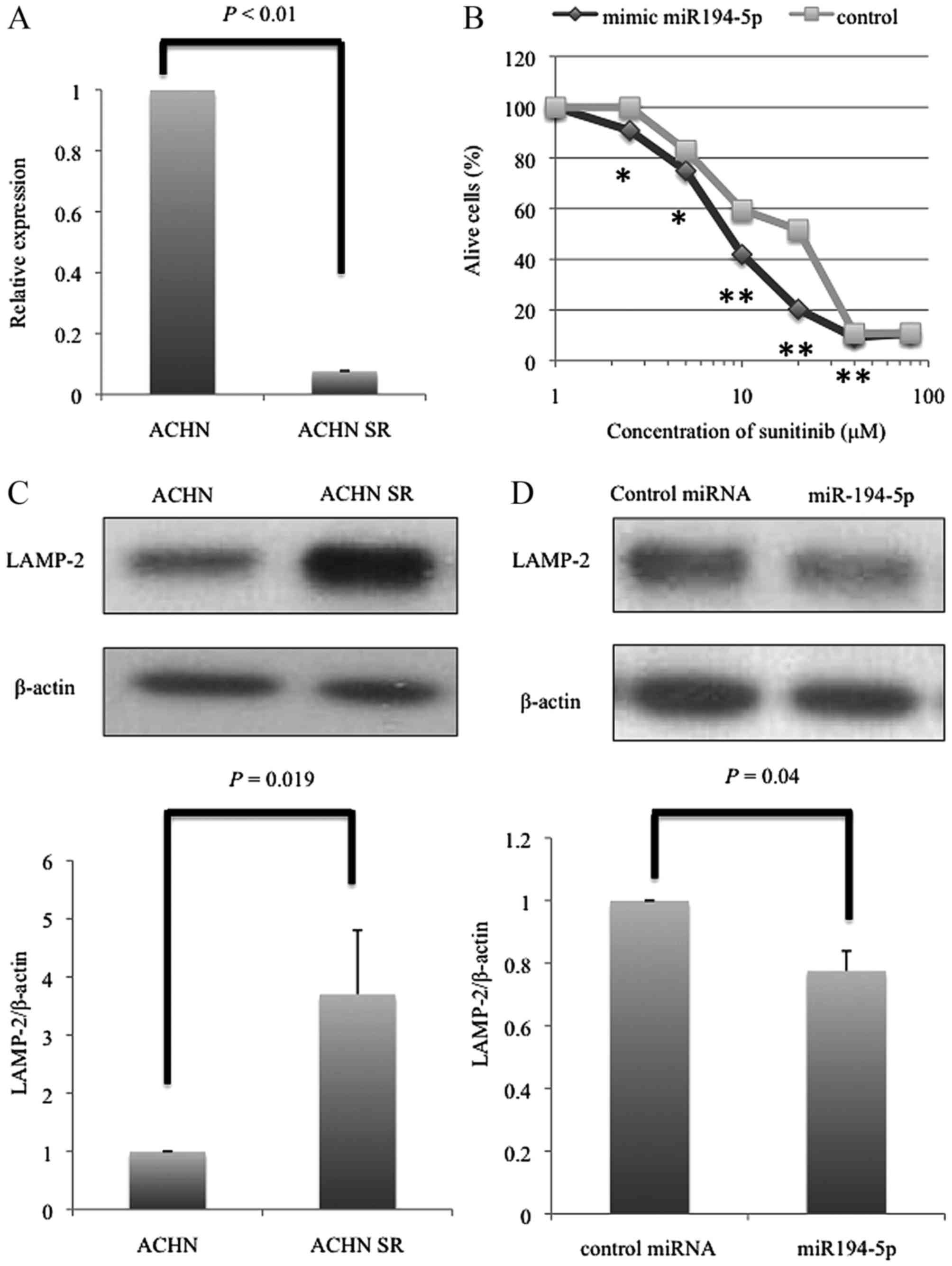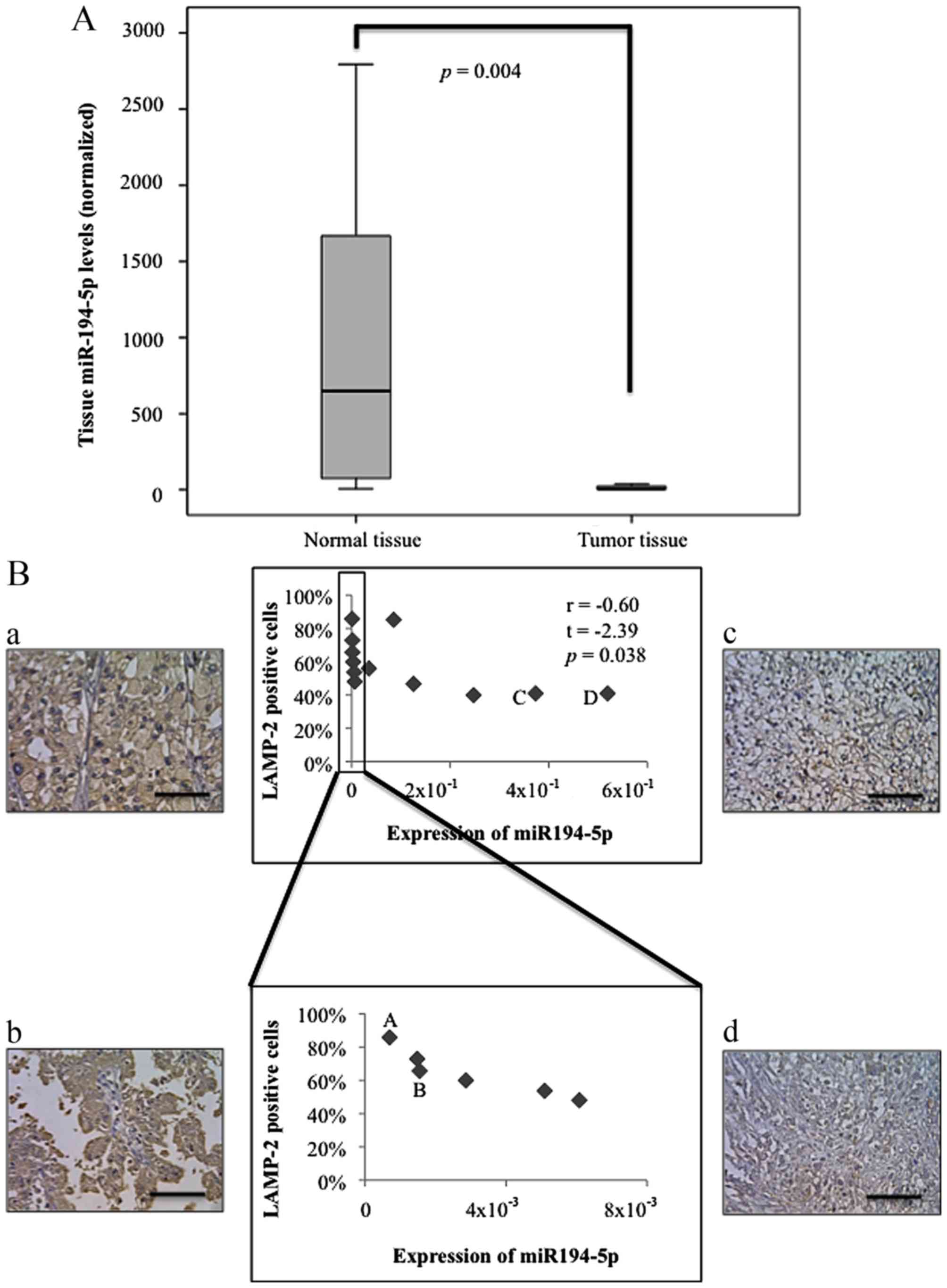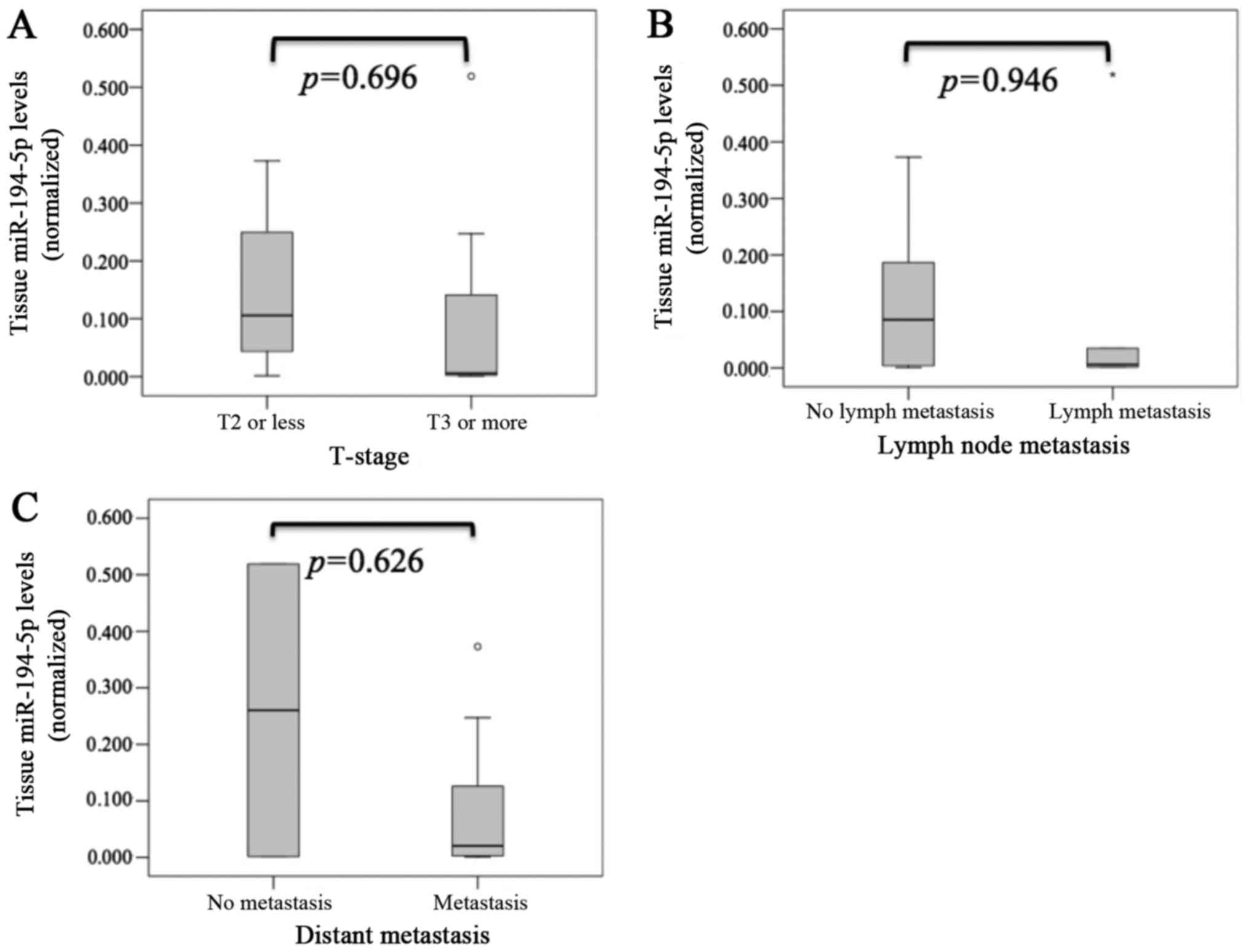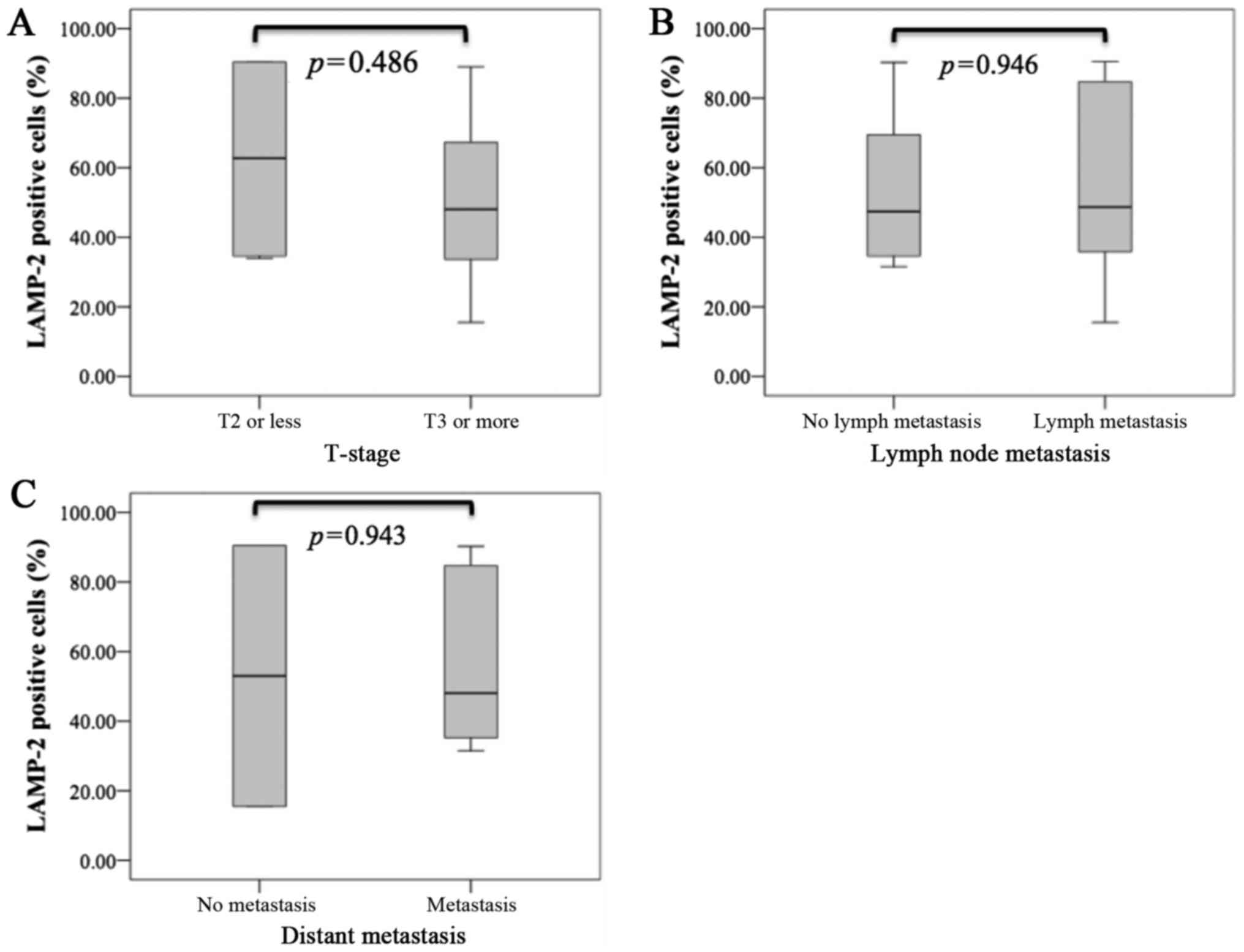Lysosome‑associated membrane protein 2 (LAMP‑2) expression induced by miR‑194‑5p downregulation contributes to sunitinib resistance in human renal cell carcinoma cells
- Authors:
- Published online on: November 15, 2017 https://doi.org/10.3892/ol.2017.7423
- Pages: 893-900
-
Copyright: © Yumioka et al. This is an open access article distributed under the terms of Creative Commons Attribution License.
Abstract
Introduction
The number of renal cell carcinoma (RCC) patients is increasing worldwide. Approximately 20% of RCC patients present with advanced stage disease at the time of diagnosis, and in patients with localized RCC, nearly 30% will experience disease recurrence after tumor resection (1,2). Targeted therapy using tyrosine kinase inhibitors (TKIs) is used as a treatment for metastatic renal cell carcinoma (mRCC). TKIs inhibit multiple receptor tyrosine kinases needed for the activation of intracellular signaling pathways controlling cell proliferation, survival, or angiogenesis. Among TKIs, sunitinib, an orally available TKI, is the most commonly used molecular-targeting agent as first-line therapy for mRCC (3). In the sunitinib registration trial, half of the treated patients with a favorable or intermediate risk score based on Memorial Sloan-Kettering Cancer Center criteria achieved an objective response, resulting in a median progression-free survival (PFS) of 11 months (4,5). However, the clinical benefit of sunitinib in PFS is limited, and the majority of mRCC patients treated with sunitinib ultimately experience disease progression due to the acquisition of resistance. In such cases, progressed patients require further sequential therapy using other TKIs or mTOR inhibitors (mTORIs). In spite of treatment of the second therapy, the median PFS was short; 4.8 months with axitinib, 3.4 months with sorafenib, 4.3 months with temsirolimus, 7.5 months with pazopanib, and 4.0 months with everolimus (6–9). Therefore, we thought that it should be necessary to lengthen PFS in first-line therapy of sunitinib. Identifying pathways responsible for intrinsic or acquired resistance could provide novel directions to develop therapies that block resistance pathways.
Intracellular drug accumulation accompanied by increased lysosomal storage is elevated in sunitinib-resistant cells (10). Moreover, the lysosomal capacity is enhanced by upregulating lysosome-associated membrane protein-1 and −2 (LAMP1/2) expression (11). Based on these data, identifying mechanisms responsible for intrinsic or acquired sunitinib resistance involving LAMP1/2 could provide novel directions to develop therapies that block resistance pathways.
microRNAs (miRNAs) are noncoding single-stranded small RNAs (~ 22 nucleotides) that regulate posttranscriptional gene expression. miRNA levels are altered in many human diseases including cancer (12). miRNAs play an important role as regulators of gene expression in tumorigenesis, tumor progression, drug resistance, and metastasis (13,14). Thus, we previously generated a sunitinib-resistant RCC cell line, SR-ACHN (sunitinib-resistant ACHN), by continuous treatment with sunitinib to detect candidate miRNAs implicated in the regulation of sunitinib resistance (15). The aim of this study was to identify miRNAs that suppressed sunitinib resistance via LAMP2 expression using ACHN and SR-ACHN cells.
Materials and methods
Cell lines
A human RCC cell line, ACHN, was purchased from the American Type Culture Collection (Rockville, MD, USA) and cultured in RPMI1640 (Thermo Fisher Scientific Inc., Waltham, MA, USA) with 10% fetal bovine serum (FBS) and 1% Penicillin-Streptomycin (Thermo Fisher Scientific Inc.). Sunitinib-resistant ACHN (SR-ACHN) cells were generated as previously described (15). SR-ACHN cells were maintained in the same medium containing 10 µM sunitinib (Sigma Aldrich, St. Louis, MO, USA).
Clinical samples
Twelve samples of advanced RCC, which had lymph node metastasis or distant metastasis, were obtained from Tottori University Hospital. All the materials were obtained with informed consent, and the procedures were approved by The Ethics Committee of Tottori University (Tottori, Japan; approval number: 1558). Tissue samples were obtained from tumor tissues and matched normal tissues from the same kidney specimen in RCC patients. Normal tissues were far from tumor clearly macroscopically.
Total RNA extraction and microarray
Total RNA from ACHN and SR-ACHN cells was extracted using the miR-Vana™ miRNA isolation kit (Thermo Fisher Scientific Inc.) following the manufacturer's protocol. Total RNA quality control for quantity and purity was determined using a NanoDrop Spectrophotometer ND-1000 (Thermo Fisher Scientific Inc.). The RNA samples were stored at −80°C until the reverse transcription (RT) reaction. For microarray analysis, total RNA was labeled using a 3D-Gene miRNA labeling kit (Toray Industries; Kamakura, Japan). Labeled RNA was hybridized to 3D-Gene human miRNA V21 chips (Toray Industries).
Transfection with synthetic miRNAs into SR-ACHN cells and proliferation assay
Synthetic human miRNAs (hsa-miRs) [hsa-miR-194-5p and negative control (NC); Ambion] were transfected into SR-ACHN cells at 60 nmol/l (final concentration) per 3×106 cell/well in a 10-cm dish, using DharmaFECT (GE Healthcare, Pittsburg, PA). After 24 h of incubation, cells were harvested and reseeded into a 96-well plate. miR transfected cells were plated at 5×103 cells/well in a 96-well plate. After 24 h, sunitinib was added at different concentrations and proliferation after 72 h was measured using the Cell Counting Kit-8 (Dojindo Molecular Technologies, Kumamoto, Japan) according to the manufacturer's protocol.
RNA extraction and quantitative real-time PCR of miRNAs
Total RNA from cell lines and clinical samples was extracted using a miR-Vana™ miRNA Isolation Kit (Thermo Fisher Scientific Inc.,) according to the manufacturer's protocol. miR-194-5p-specific complementary DNA was generated from 20 ng total RNA, using the TaqMan MicroRNA RT kit (Applied Biosystems, Foster City, CA) and the miR-194-5p-specific RT-primer from the TaqMan Micro RNA Assay (Applied Biosystems). miR-194-5p levels were also measured using the miR-194-5p-specific probe included with the TaqMan Micro RNA Assay on an ABI 7900HT System and SDS software (Applied Biosystems).
Western blotting
The cells were lysed with cell lysis buffer {1 mmol/l Na3VO4, 100 mmol/l phenylmethylsulfonyl fluoride (PMSF), 500 mmol/l NaF, 500 mmol/l ethylenediaminetetraacetic acid (EDTA), 10% NP-40, 2 mg/ml aprotinin, 2 mg/ml leuptin, 1 mol/l Tris pH 7.6, 5 mol/l NaCl and distilled water}. Protein concentrations were determined by the Micro BCA protein assay (Thermo Fisher Scientific Inc.). Samples containing 20 µg protein underwent electrophoresis on 10% SDS polyacrylamide gels and were subsequently transferred to PVDF membranes. The membranes were blotted with a mouse monoclonal antibody against LAMP-2 (1:250; ab119124; Abcam, Cambridge, MA), or with a monoclonal antibody against β-actin (1:2,000; AC-15; Sigma, Aldrich).
Signals were visualized using an enhanced chemiluminescence system (ECL Detection System; Amersham Pharmacia Biotech, Piscataway, NJ).
Immunohistochemistry
Clinical tissues were fixed in 10% formalin and embedded in paraffin. Sections 3-µm thick were examined by immunohistochemistry. The sections were deparaffinized and antigens were retrieved using an autoclave in 10 mmol/l citrate buffer (pH 6.0) at 121°C for 10 min. Endogenous peroxidase activity was blocked by immersing the slides in 0.6% hydrogen peroxide in methanol for 20 min. The sections were immunostained using a Histofine rabbit stain kit (Nichirei, Tokyo, Japan). The primary antibody was a mouse monoclonal antibody against LAMP-2 (1:10; ab25631; Abcam) followed by incubation with secondary antibodies. Immunoreactions were visualized with diaminobenzidine and the sections were counterstained with hematoxylin.
Statistical analysis
Statistical significance was determined by the two-tailed unpaired Student's t-test and using the Pearson correlation coefficient. Differences were considered to be statistically significant when P<0.05.
Results
miRNA microarray analysis and validation of the array data by real-time RT-qPCR
A pair of cell lines (ACHN and SR-ACHN) was used to identify miRNA candidates involved in regulating sunitinib resistance, based on the premise that sunitinib resistance-related miRNAs are identifiable by comparing the miRNA expression patterns in these cells. miRNA microarray analysis was performed by comparing ACHN and SR-ACHN cells to evaluate the miRNA profiles of each cell type. The expression levels of many miRNAs were different between the two cell lines. Fifteen miRNAs were significantly upregulated over 8-fold (sunitinib-resistant miRNAs) whereas thirty-one miRNAs, including miR-194-5p, were significantly down-regulated over 4-fold in SR-ACHN compared with that in ACHN cells (Table I).
Table I.microRNAs in sunitinib-resistant ACHN cells increase 8-fold and decrease 4-fold when compared with ACHN cells. |
On the basis of the microarray results, we further examined the expression level of miR-194-5p by real-time RT-qPCR. We selected miR-194-5p based on a previous study, which reported that higher miR-194 expression correlated with significantly longer disease-free survival and overall survival compared to those with lower expression in patients with RCC (16). RNA pools from the same RNA samples used for the microarray experiments were prepared. We used RNU6B as a reference gene for normalization of the miRNA data. The CT values of miR-194-5p were significantly decreased in SR-ACHN cells compared with that in ACHN cells (P<0.01) (Fig. 1A). The PCR result was consistent with the microarray data.
miRNA mimic oligonucleotide transfer restores sunitinib resistance in ACHN cell lines
The IC50 concentration of sunitinib for ACHN and SR-ACHN cells was 10 and 21 µM, respectively, showing that SR-ACHN cells exhibited significantly higher resistance to sunitinib treatment compared with ACHN cells, as previously reported by Yamaguchi et al (15). When SR-ACHN cells transfected with miR-194-5p or negative control miR were treated with sunitinib, the number of live cells was significantly decreased in miR-194-5p-transfected cells than in negative control miR-transfected SR-ACHN cells at a sunitinib concentration range of 2.5 to 40 µM (Fig. 1B).
Detection and identification of miR-194-5p target genes
To elucidate sunitinib resistance-related miR-194-5p target genes in SR-ACHN cells, candidate target genes were selected using miRDB 5.0. Out of the many miR-194-5p target genes, we focused on LAMP2, which is known to contribute to sunitinib resistance in renal cell cancer cells (17). In fact, western blot analysis revealed that LAMP2 protein expression was markedly higher in SR-ACHN cells than in ACHN cells (P=0.019, Fig. 1C). These data motivated us to examine whether miR-194-5p could suppress the expression of LAMP2 in SR-ACHN cells. As shown in Fig. 1D, the expression of LAMP-2 was significantly decreased by miR-194-5p transfection compared with that by miR-NC transfection (P=0.04).
Expression of miR-194-5p and LAMP-2 in clinical samples
Finally, we evaluated the expression of miR-194-5p in human advanced RCC samples from radical nephrectomies. The characteristics of clinical samples are shown in Table II. Twelve samples of advanced RCC were analyzed for the expression of miR-194-5p by RT-qPCR. The miR-194-5p expression data were normalized to that of RNU6B. Tissue miR-194-5p levels were significantly lower in tumor tissues than in normal tissues (P=0.004, Fig. 2A). LAMP-2 expression was evaluated by immunohistopathology. As shown in Fig. 2B, LAMP2 immunoreactivity was observed in tumor cell cytoplasm. The percentage of LAMP-2-positive tumor cells was inversely correlated to miR-194-5p expression levels (r=−0.60, t=−2.39, P=0.038). Although we analyzed the relationship between miR-194-5p or LAMP-2 expression and clinicopathological parameters, there were no significant differences in T stage, lymph node metastasis, and distant metastasis for miR-194-5p (Fig. 3) or LAMP-2 (Fig. 4).
Discussion
Although sunitinib is a TKI indicated as a first-line treatment for mRCC, the clinical benefit of sunitinib in PFS is limited, and the majority of mRCC patients treated with sunitinib ultimately experience disease progression due to the acquisition of resistance (3–5). miRNAs play a crucial role in modulating the sensitivity to chemotherapeutic agents in multiple tumors (18,19), indicating that miRNAs are promising therapeutic targets in cancers. Therefore, identifying miRNAs that could eliminate resistance to sunitinib in RCC cells may help elucidate the mechanism of sunitinib resistance and clinically benefit RCC patients. The present study revealed that restoring miR-194-5p expression in SR-ACHN cells sensitized to sunitinib via down-regulating LAMP2, a possible target of miR-194-5p in RCC cells, increased sunitinib sensitivity. It is strongly suggested that over-expression of LAMP2 by inhibiting miR-194-5p may lead to sunitinib resistance acquisition.
There is only one study showing that miR-194-5p is associated with drug resistance in human cancers. Zhu et al reported that miR-194-5p is down-regulated in the cisplatin-resisted human non-small cell lung cancer cell line-A549/DDP and over-expression of miR-194-5p increases cisplatin sensitivity via down-regulating FOXA1, a target of miR-194-5p (20). However, the paper reported that down-regulation of miR-194-5p contributed to drug resistance against cisplatin, but not sunitinib. So far, various miRNAs have been reported to contribute to sunitinib resistance in RCCs (12,21–23). For example, Merhautova et al reported that decreased tissue levels of miR-155 and miR-484 are significantly associated with prolonged time to progression in RCC patients treated with sunitinib (21). In addition, Berkers et al reported that miR-141 down-regulation-driven epithelial-to-mesenchymal transition (EMT) in clear cell carcinoma is associated with an unfavorable response to sunitinib, indicating that low miR-141 expression results in poor prognosis (22). Goto et al reported that miR-101 is markedly suppressed in sunitinib-treated RCC tissues and restoration of miR-101 significantly inhibits migration and invasion in Caki-1 and 786-O cells (23). A comprehensive analysis screened 673 miRNAs in tumor tissues from mRCC patients and revealed that higher miR-942 expression is an independent predictor of inadequate sunitinib efficacy (12). Although such miRNAs related to sunitinib resistance might be useful as prognostic markers, no data was shown regarding whether the altered expression of such miRNAs directly gave rise to sunitinib-resistant RCCs. Our data showed that not only low-expression of miR-194-5p was associated with resistance against sunitinib, but also susceptibility to sunitinib was ameliorated by miR-194-5p restoration in RCC cells via LAMP-2 down-regulation.
LAMP-2 is present at the lysosomal membrane and contributes to lysosome function. In recent studies, the lysosome was associated with the sunitinib resistance mechanism. Giuliano et al reported that sequestration of sunitinib in lysosomes and the subsequent inhibition of the autophagy flux participate in sunitinib resistance (24). The incomplete autophagic flux is caused by suppression of the lysosomal protease cathepsin B activity. In addition, Gotink et al reported fluorescent microscopy data revealing intracellular sunitinib distribution mainly in acidic lysosomes, which are also significantly increased in sunitinib-resistant renal cancer cells compared to that in parental cells (25). These data indicate that sunitinib resistance is dependent on the lysosomal capacity, which is reflected by the LAMP-2 expression level. Therefore, expansion of sunitinib accumulation in lysosomes may be induced by increasing LAMP-2 expression, contributing to sunitinib resistance in mRCC cells.
We investigated the relationship between miR-194-5p or LAMP-2 expression and T-stage, lymph node metastasis, and distant metastasis, and found there were no significant differences. In the previous report, Lee et al reported that miR-194-5p might be used as diagnostic biomarkers in adenocarcinoma in uterine cervix, but there were no significant differences between miR-194-5p and T-stage, lymph node metastasis, and distant metastasis (26). In addition, LAMP-1 might influence local tumor progression rather than the formation of tumor metastasis in pancreatic carcinoma, but no relation was found between LAMP-2 and the tumor stage or lymph node metastasis (27). In lung cancer, Giatromanolaki et al reported that LAMP-2 was related to high histology grade, and was not related tumor stage (28). However, many reports described that LAMP2 was related to drug resistance (24,25). These data showed that these two molecules contributed to drug resistance acquisition by sunitinib uptake by lysosomes, and suggested that down-regulation of LAMP-2 by miR-194-5p was independent of cell proliferation, cell death resistance, invasion, and metastasis. Therefore, we thought that clarifying the intracellular signaling transmission pathways regulated by miR-194-5p could identify mechanisms responsible for intrinsic or acquired sunitinib resistance.
In conclusion, we have identified miR-194-5p as a sunitinib-resistant suppressive miRNA that down-regulates LAMP2 in human RCC cells. Targeting miR-194-5p could contribute to a new therapy against sunitinib resistance and improve PFS for patients with mRCC.
References
|
Capitanio U and Montorsi F: Renal cancer. Lancet. 387:894–906. 2016. View Article : Google Scholar : PubMed/NCBI | |
|
Eggener SE, Yossepowitch O, Pettus JA, Snyder ME, Motzer RJ and Russo P: Renal cell carcinoma recurrence after nephrectomy for localized disease: Predicting survival from time of recurrence. J Clin Oncol. 24:3101–3106. 2006. View Article : Google Scholar : PubMed/NCBI | |
|
Schmidinger M, Larkin J and Ravaud A: Experience with sunitinib in the treatment of metastatic renal cell carcinoma. Ther Adv Urol. 4:253–265. 2012. View Article : Google Scholar : PubMed/NCBI | |
|
Motzer RJ, Hutson TE, Tomczak P, Michaelson MD, Bukowski RM, Oudard S, Negrier S, Szczylik C, Pili R, Bjarnason GA, et al: Overall survival and updated results for sunitinib compared with interferon alfa in patients with metastatic renal cell carcinoma. J Clin Oncol. 27:3584–3590. 2009. View Article : Google Scholar : PubMed/NCBI | |
|
Motzer RJ, Bacik J and Mazumdar M: Prognostic factors for survival of patients with stage IV renal cell carcinoma: Memorial sloan-kettering cancer center experience. Clin Cancer Res. 10:6302S–6303S. 2004. View Article : Google Scholar : PubMed/NCBI | |
|
Rini BI, Escudier B, Tomczak P, Kaprin A, Szczylik C, Hutson TE, Michaelson MD, Gorbunova VA, Gore ME, Rusakov IG, et al: Comparative effectiveness of axitinib versus sorafenib in advanced renal cell carcinoma (AXIS): A randomised phase 3 trial. Lancet. 378:1931–1939. 2011. View Article : Google Scholar : PubMed/NCBI | |
|
Hutson TE, Escudier B, Esteban E, Bjarnason GA, Lim HY, Pittman KB, Senico P, Niethammer A, Lu DR, Hariharan S and Motzer RJ: Randomized phase III trial of temsirolimus versus sorafenib as second-line therapy after sunitinib in patients with metastatic renal cell carcinoma. J Clin Oncol. 32:760–767. 2014. View Article : Google Scholar : PubMed/NCBI | |
|
Hainsworth JD, Rubin MS, Arrowsmith ER, Khatcheressian J, Crane EJ and Franco LA: Pazopanib as second-line treatment after sunitinib or bevacizumab in patients with advanced renal cell carcinoma: A Sarah Cannon Oncology Research Consortium Phase II trial. Clin Genitourin Cancer. 11:270–275. 2013. View Article : Google Scholar : PubMed/NCBI | |
|
Motzer RJ, Escudier B, Oudard S, Hutson TE, Porta C, Bracarda S, Grünwald V, Thompson JA, Figlin RA, Hollaender N, et al: Efficacy of everolimus in advanced renal cell carcinoma: A double-blind, randomised, placebo-controlled phase III trial. Lancet. 372:449–456. 2008. View Article : Google Scholar : PubMed/NCBI | |
|
Gotink KJ, Rovithi M, de Haas RR, Honeywell RJ, Dekker H, Poel D, Azijli K, Peters GJ, Broxterman HJ and Verheul HM: Cross-resistance to clinically used tyrosine kinase inhibitors sunitinib, sorafenib and pazopanib. Cell Oncol (Dordr). 38:119–129. 2015. View Article : Google Scholar : PubMed/NCBI | |
|
Saftig P and Klumperman J: Lysosome biogenesis and lysosomal membrane proteins: Trafficking meets function. Nat Rev Mol Cell Biol. 10:623–635. 2009. View Article : Google Scholar : PubMed/NCBI | |
|
Kong YW, Ferland-McCollough D, Jackson TJ and Bushell M: microRNAs in cancer management. Lancet Oncol. 13:e249–e258. 2012. View Article : Google Scholar : PubMed/NCBI | |
|
Slaby O, Jancovicova J, Lakomy R, Svoboda M, Poprach A, Fabian P, Kren L, Michalek J and Vyzula R: Expression of miRNA-106b in conventional renal cell carcinoma is a potential marker for prediction of early metastasis after nephrectomy. J Exp Clin Cancer Res. 29:902010. View Article : Google Scholar : PubMed/NCBI | |
|
Iwamoto H, Kanda Y, Sejima T, Osaki M, Okada F and Takenaka A: Serum miR-210 as a potential biomarker of early clear cell renal cell carcinoma. Int J Oncol. 44:53–58. 2014. View Article : Google Scholar : PubMed/NCBI | |
|
Yamaguchi N, Osaki M, Onuma K, Yumioka T, Iwamoto H, Sejima T, Kugoh H, Takenaka A and Okada F: Identification of MicroRNAs involved in resistance to sunitinib in renal cell carcinoma cells. Anticancer Res. 37:2985–2992. 2017.PubMed/NCBI | |
|
Nofech-Mozes R, Khella HW, Scorilas A, Youssef L, Krylov SN, Lianidou E, Sidiropoulos KG, Gabril M, Evans A and Yousef GM: MicroRNA-194 is a marker for good prognosis in clear cell renal cell carcinoma. Cancer Med. 5:656–664. 2016. View Article : Google Scholar : PubMed/NCBI | |
|
Gotink KJ, Broxterman HJ, Honeywell RJ, Dekker H, de Haas RR, Miles KM, Adelaiye R, Griffioen AW, Peters GJ, Pili R and Verheul HM: Acquired tumor cell resistance to sunitinib causes resistance in a HT-29 human colon cancer xenograft mouse model without affecting sunitinib biodistribution or the tumor microvasculature. Oncoscience. 1:844–853. 2014. View Article : Google Scholar : PubMed/NCBI | |
|
Ayers D and Vandesompele J: Influence of microRNAs and long non-coding RNAs in cancer chemoresistance. Genes (Basel). 8:pii: E952017. View Article : Google Scholar | |
|
An X, Sarmiento C, Tan T and Zhu H: Regulation of multidrug resistance by microRNAs in anti-cancer therapy. Acta Pharm Sin B. 7:38–51. 2017. View Article : Google Scholar : PubMed/NCBI | |
|
Zhu X, Li D, Yu F, Jia C, Xie J, Ma Y, Fan S, Cai H, Luo Q, Lv Z and Fan L: miR-194 inhibits the proliferation, invasion, migration, and enhances the chemosensitivity of non-small cell lung cancer cells by targeting forkhead box A1 protein. Oncotarget. 7:13139–13152. 2016. View Article : Google Scholar : PubMed/NCBI | |
|
Merhautova J, Hezova R, Poprach A, Kovarikova A, Radova L, Svoboda M, Vyzula R, Demlova R and Slaby O: miR-155 and miR-484 are associated with time to progression in metastatic renal cell carcinoma treated with sunitinib. Biomed Res Int. 2015:9419802015. View Article : Google Scholar : PubMed/NCBI | |
|
Berkers J, Govaere O, Wolter P, Beuselinck B, Schöffski P, van Kempen LC, Albersen M, van den Oord J, Roskams T, Swinnen J, et al: A possible role for microRNA-141 down-regulation in sunitinib resistant metastatic clear cell renal cell carcinoma through induction of epithelial-to-mesenchymal transition and hypoxia resistance. J Urol. 189:1930–1938. 2013. View Article : Google Scholar : PubMed/NCBI | |
|
Goto Y, Kurozumi A, Nohata N, Kojima S, Matsushita R, Yoshino H, Yamazaki K, Ishida Y, Ichikawa T, Naya Y and Seki N: The microRNA signature of patients with sunitinib failure: Regulation of UHRF1 pathways by microRNA-101 in renal cell carcinoma. Oncotarget. 7:59070–59086. 2016. View Article : Google Scholar : PubMed/NCBI | |
|
Giuliano S, Cormerais Y, Dufies M, Grépin R, Colosetti P, Belaid A, Parola J, Martin A, Lacas-Gervais S, Mazure NM, et al: Resistance to sunitinib in renal clear cell carcinoma results from sequestration in lysosomes and inhibition of the autophagic flux. Autophagy. 11:1891–1904. 2015. View Article : Google Scholar : PubMed/NCBI | |
|
Gotink KJ, Broxterman HJ, Labots M, de Haas RR, Dekker H, Honeywell RJ, Rudek MA, Beerepoot LV, Musters RJ, Jansen G, et al: Lysosomal sequestration of sunitinib: A novel mechanism of drug resistance. Clin Cancer Res. 17:7337–7346. 2011. View Article : Google Scholar : PubMed/NCBI | |
|
Lee H, Kim KR, Cho NH, Hong SR, Jeong H, Kwon SY, Park KH, An HJ, Kim TH, Kim I, et al: MicroRNA expression profiling and Notch1 and Notch2 expression in minimal deviation adenocarcinoma of uterine cervix. World J Surg Oncol. 12:3342014. View Article : Google Scholar : PubMed/NCBI | |
|
Künzli BM, Berberat PO, Zhu ZW, Martignoni M, Kleeff J, Tempia-Caliera AA, Fukuda M, Zimmermann A, Friess H and Büchler MW: Influences of the lysosomal associated membrane proteins (Lamp-1, Lamp-2) and Mac-2 binding protein (Mac-2-BP) on the prognosis of pancreatic carcinoma. Cancer. 94:228–239. 2002. View Article : Google Scholar : PubMed/NCBI | |
|
Giatromanolaki A, Kalamida D, Sivridis E, Karagounis IV, Gatter KC, Harris AL and Koukourakis MI: Increased expression of transcription factor EB (TFEB) is associated with autophagy, migratory phenotype and poor prognosis in non-small cell lung cancer. Lung Cancer. 90:98–105. 2015. View Article : Google Scholar : PubMed/NCBI |













